the place where Paleontology and Paleoanthropology meets Philately
Greece 2022 "Geoparks of Greece"
| <prev |
| Issue Date | 05.06.2022 |
| ID | Michel: 3152-3156, Scott: 2980-2984, Stanley Gibbons:, Yvert & Tellier: 3363-3368, Category: pF. |
| Designer | |
| Stamps in set | 5 |
| Value |
1,00€ Vikos – Aoos Geopark 1,00€ Lesvos Geopark 1,50€ Psiloritis Geopark 2,00€ Chelmos – Vouraikos Geopark 2,50€ Sitia Geopark |
| Type | commemorative |
| Size (width x height) | 35mm x 45mm |
| Layout | Sheets of 25 stamps |
| Products | FDC x2, Numbered Set Pack x1 |
| Paper | |
| Perforation | 14 x 13.75 |
| Print Technique | Offset lithography |
| Printed by | Veridos Matsoukis SA |
| Quantity | 20.000 stamp sets, 3.500 sets of FDC, 500 Numbered Set Packs |
| Issuing Authority | Hellenic Post |
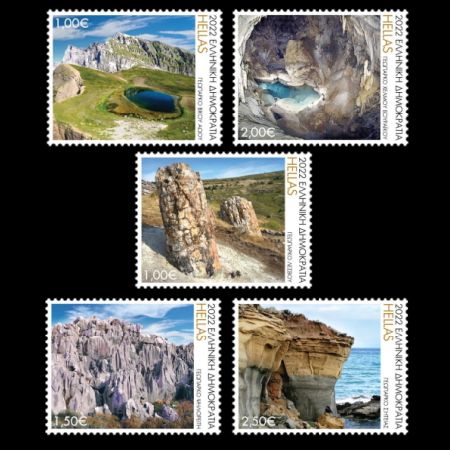
On 5th June 2022, the Postal Authority of Greece issued a set of 5 stamps "Geoparks of Greece". One of the stamps shows a pair of trunks of petrified trees in the Lesvos (Lesbos) Geopark.
Located on the island of Lesvos (North Aegean Region, Nord-East of Greece), the Petrified Forest of Lesvos is one of the most important natural heritage monuments in the world. The fossilized trees include the highest standing fossilized tree in the world, with a height of 7.20 meters and a circumference of 8.58 meters. To protect and promote the wonders of this ancient forest, the Greek state declared the area a Protected Natural Monument in 1985. It was included in the Global Geoparks Network in 2004 and it was proposed for UNESCO's Tentative List of World Heritage Sites in 2014. In November 2015, Lesvos Island was recognized as one of UNESCO’s Global Geoparks.
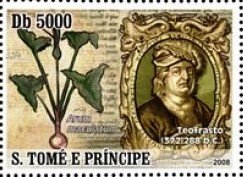
|
| The only stamp depicting Theophrastus’ was issued in 2008 in the set of "Naturalists" by Sao Tomé and Príncipe, who issued over 450 stamps that year. MiNr.: 3390, Scott: |
The first references to the fossils of Lesvos can be found in Theophrastus’ works.
Theophrastus of Eressos, who was born circa 371 BC in the area of the Petrified Forest of Lesvos,
was one of the greatest thinkers, scientists and philosophers of antiquity, the successor to Aristotle,
and the first scientist to recognize fossils, to which he devoted special attention.
Almost 2000 years after the very first recording of Lesvos plant fossils by Theophrastus,
scientific interest returned to Lesvos.
In 1842 during the annual exhibit of fossils at the Landesmuseum Joanneum
(today, the Universalmuseum Joanneum) in Graz Austria exhibited fossils plants from the island of Lesvos.
These fossils had been collected by the Archduke Johann.
What should be underlined is the fact that the Professor of Botany and Director of the famous Botanical
Garden of this institution from 1835 until 1849 was Franz Unger (1800-1870).
Unger described the fossilized trunks in his books on the Past World (1841-1847)
and in articles describing his trip to Greece (1862).
Unger’s publications inspired large numbers of researchers to visit Lesvos and the Petrified
Forest in the 19th century to study the fossil site.
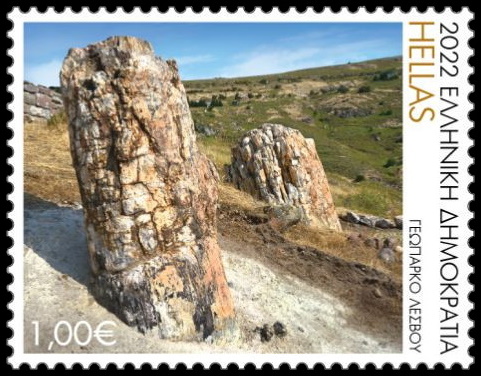
|
| Petrified trunks in the Petrified Forest Park in Lesvos island of Greece, MiNr.:, Scott: |
Fossils of 25 species of conifers and 5 species of angiosperms have been identified from the fossilized wood. The foliage has a different composition, with the majority of the leaves being from angiosperms.
These fossils have are impressed by a palette of vivid colours. Variable colours are noticed not only in fossil plants from the same locality, but within a single fossil plant itself.
Several factors affect the distribution of different colours within the fossilized plants: the nature of pyroclastic rocks and the hydrothermal solutions produced during the volcanic activity; the silicification process itself (replacement of the cell-wall structure or void-filling with silica, i.e., permineralization); the possibility of a multi-stage petrification and the subsequent mobility of chemical elements therein; the palaeoenvironmetal conditions (hydrology, pH, Eh etc.); the type of species and the variability of plant tissues within the same species.
The main colours observed are black, milky white, transparent white, green, red, orange, brown and yellow.
| FDC | The Numbered Set Pack | |
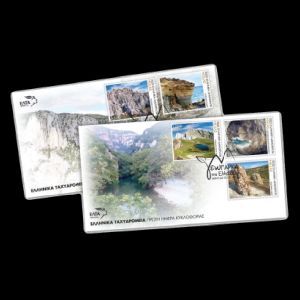
|
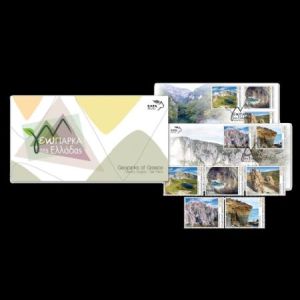
|
|
References

|
- [R1] Technical details and stamps presentation: Press release of Hellenic Post.
-
[R2] Lesvos Petrified Forest:
Wikipedia,
UNESCO,
European Geoparks,
"Lesvos Petrified Forest: the fascinating colours of the silicified trunks", by A. Iordanidis, J. Garcia-Guinea, N. Zouros, A. Asvesta - [R3] Theophrastus: Wikipedia, On Stones (with translation to English).
- [R4] Natural History Museum of the Lesvos Petrified Forest: official website,
Acknowledgements
Many thanks to Dr. Peter Voice from Department of Geological and Environmental Sciences, Western Michigan University, for reviewing the draft page .
| <prev |